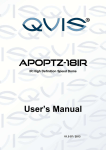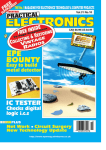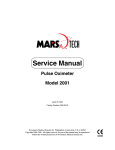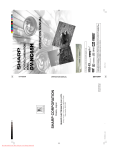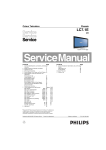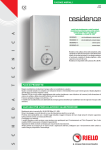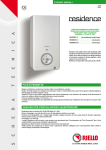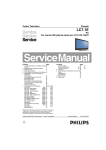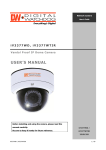Download PS-416M User & Service Manual
Transcript
PS-416M User & Service Manual PATIENT SIMULATOR 1-1 Copyright © 1997 by METRON. All rights reserved. METRON: USA 1345 Monroe NW, Suite 255A Grand Rapids, MI 49505 Phone: (+1) 888 863-8766 Fax: (+1) 616 454-3350 E-mail: [email protected] FRANCE 30, rue Paul Claudel 91000 Evry, France Phone: (+33) 1 6078 8899 Fax: (+33) 1 6078 6839 E-mail: [email protected] NORWAY Travbaneveien 1 N-7044 Trondheim, Norway Phone: (+47) 7382 8500 Fax: (+47) 7391 7009 E-mail: [email protected] Disclaimer METRON provides this publication as is without warranty of any kind, either express or implied, including but not limited to the implied warranties of merchantability or fitness for any particular purpose. Further, METRON reserves the right to revise this publication and to make changes from time to time to the content hereof, without obligation to METRON or its local representatives to notify any person of such revision or changes. Some jurisdictions do not allow disclaimers of expressed or implied warranties in certain transactions; therefore, this statement may not apply to you. Limited Warranty METRON warrants that the PS-416M Patient Simulator will substantially conform to published specifications and to the documentation, provided that it is used for the purpose for which it was designed. METRON will, for a period of twelve (12) months from date of purchase, replace or repair any defective analyzer, if the fault is due to a manufacturing defect. In no event will METRON or its local representatives be liable for direct, indirect, special, incidental, or consequential damages arising out of the use of or inability to use the PS-416M Patient Simulator, even if advised of the possibility of such damages. METRON or its local representatives are not responsible for any costs, loss of profits, loss of data, or claims by third parties due to use of, or inability to use the PS-416M Patient Simulator. Neither METRON nor its local representatives will accept, nor be bound by any other form of guarantee concerning the PS-416M Patient Simulator other than this guarantee. Some jurisdictions do not allow disclaimers of expressed or implied warranties in certain transactions; therefore, this statement may not apply to you. Trademarks Duracell is a registered trademark of Duracell, Inc. 1-2 Table of Contents MANUAL REVISION RECORD ...................................................................................................... 1-5 1. INTRODUCTION ........................................................................................................................ 1-7 1.1 PS-416M Features ................................................................................................................. 1-7 1.2 Specifications......................................................................................................................... 1-7 1.3 General Information .............................................................................................................. 1-9 2. INSTALLATION ....................................................................................................................... 2-11 2.1 Receipt, Inspection and Return............................................................................................ 2-11 3. OPERATING PS-416M ............................................................................................................. 3-13 3.1 Control Switches and Terminals.......................................................................................... 3-13 3.2 Use....................................................................................................................................... 3-14 4. CONTROL AND CALIBRATION........................................................................................... 4-17 4.1 Required Equipment ............................................................................................................ 4-17 4.2 Preparation........................................................................................................................... 4-17 4.3 Function Testing .................................................................................................................. 4-17 5. COMPONENT FUNCTIONS AND PARTS ........................................................................... 5-21 5.1 Theory of Operation ............................................................................................................ 5-21 5.2 Functions Description.......................................................................................................... 5-21 5.3 Component Parts.................................................................................................................. 5-23 APPENDIX A: DIAGRAMS ........................................................................................................... 5-27 Component Location .................................................................................................................... 5-29 Schematic Diagram Part 1 ........................................................................................................... 5-30 Schematic Diagram Part 2 ........................................................................................................... 5-31 APPENDIX B: ERROR REPORT FORM, PS-416M .................................................................. 5-33 APPENDIX C: SUGGESTION FORM, PS-416M........................................................................ 5-35 1-3 This page intentionally left blank. 1-4 Manual Revision Record This record page is for recording revisions to your PS-416M User and Service Manual that have been published by METRON or its authorized representavtives. We recommend that only the management or facility representative authorized to process changes and revisions to publications: • make the pen changes or insert the revised pages; • ensure that obsolete pages are withdrawn and either disposed of immediately, or marked as superseded and placed in a superseded document file, and; • enter the information below reflecting that the revisions have been entered. Rev No Date Entered Reason 0 - Initial Release Signature of Person Entering Change 1-5 This page intentionally left blank. 1-6 1. Introduction This chapter describes the METRON PS-416M Patient Simulator’s features and specifications. 1.1 PS-416M Features METRON’s PS-416M is a high performance simulator designed to simplify patient monitor testing, and is designed to be used by trained service technicians. It simulates electrocardiogram, respiration, dynamic blood pressure and static temperature. It offers three preprogrammed automatic test modes (ECG rate, ECG performance rate, and BP level), plus a built-in ECG lead continuity test. Arrhythmia selection includes two supraventricular, two-conduction; eight ventricular, one paced; and one fetal/maternal ECG simulation. 1.2 Specifications 1. ECG General Lead Configuration: 12-lead simulation derived from one resistively divided analog signal. RL, RA, LA, LL, V1-6 Output Impedance Limb leads: 500 or 1000 ohms to RL V Leads: 1000 ohms to RL High Level Output: 2. 0.5 V/mV of low level (Lead II) Normal Sinus Rates: 30, 60, 80, 120, 180, and 300 BPM Rate Accuracy: ± 1% of selection Amplitudes: 0.5mV, 1.0mV, 1.5mV and 2.0mV (Lead II) Amplitude Accuracy: ± 5%. (Lead II 1.0mV) Automatic ECG Rate Test 3. 4. Manual ECG Performance Test Square Wave: 2.0Hz 1.0 V p-p biphasic DC pulse: 4.0 sec. 1.0 mV Sine Waves: 0.1, 0.5, 10, 40, 50, 60 and 100 Hz Triangle Wave: 2.0 Hz Amplitude: 0.5mV, 1.0mV, 1.5mV and 2.0mV (Lead II) Amplitude Accuracy: ± 5%. (Lead II 1.0mV) Automatic ECG Performance Test 1-7 Gain/Damping: 2 Hz square wave Frequency Response Low Frequency: 4 second DC pulse Band Pass: 10 Hz sine Monitor: 5. -3dB point: 40 Hz sine Power Line Notch Filter: 50 Hz sine Linearity: 2 Hz triangle wave ECG Lead Test Display flashes if lead resistance is <3 kOhms (DC lead wire only) 6. Blood Pressure General Input/Output Impedance: 7. 8. 300 Ohms Exciter Voltage Range: 2 to 16 volts Exciter Frequency Range: DC to 4000 Hz Output Sensitivity: 5 or 40 µV/V/mmHg Accuracy: ± 1% full scale 1 mmHg Calibrated Rate: 80 BPM Dynamic Blood Pressure Selections Atmosphere: 0 mmHg Arterial: 120/80 mmHg Left Ventricle: 20/0 mmHg Right Ventricle: 25/0 mmHg Pulmonary Artery: 25/10 mmHg Pulmonary Wedge: 10/2 Static Levels: 0, 20, 40, 80, 100, 200, 250, 300 mmHg mmHg Arrhythmia Selections Atrial Fibrillation 1 & 2 Premature Atrial Contraction Premature Ventricular Contraction (PVC) Early PVC R on T PVC Multifocal PVCs Bigeminy Bigeminy Run of 5 PVCs Ventricular Tachycardia Ventricular Fibrillation Second Degree Type 2 Right Bundle Branch Block Asynchronous Pacemaker Fetal/Maternal ECG 1-8 9. Respiration Normal Physiological Simulation Baseline Impedances: 500 to 1000 Ohms Impedance Variations: 0.1, 0.2, 0.5, 1.0, and 3.0 Ohms Rates: 0 (Apnea), 15, 20, 30, 40, 60, 120 BPM Output Configuration: Lead 1, 11, RL-LL 10. Temperature 30°C / 86°F, 37°C / 98.6°F, 40°C / 104°F Compatible with YSI 400/700 series. Accuracy: ± 0.25°C 1.3 General Information Display/Control: 2-digit numeric display keys 5 switches for BP, respiration, temperature and Power On/Off ECG Output Connectors High Level: Low level: Standard phone jack 10 AHA color-coded standard safety banana connectors with detachable banana to snap adapter. Power: 9 V alkaline battery or battery eliminator Case: High impact plastic Weight: 0.5 kg / 1.1 lbs. Dimensions: Height: 47 mm / 1.8 in. Width: 138 mm / 5.4 in. Length: 190 mm / 7.5 in. Standard Accessories: PS-416M Patient Simulator (P.N. 17020) 110 V or 220 V AC Adapter (P.N. 17021) Carrying Case (P.N. 17022) Snap-to-Banana Adapters (10pk) (P.N. 17023) User and Service Manual PS-416M (P.N. 17025) Optional Accessories: Unterminated or prewired BP Cable (P.N. 17440) Unterminated or prewired 400/700 YSI-series Temperature Cable (P.N. 17443) 1-9 This page intentionally left blank. 1-10 2. Installation This chapter explains unpacking, receipt inspection and claims, and the general procedures for PS-416M setup. 2.1 Receipt, Inspection and Return 1. Inspect the outer box for damage. 2. Carefully unpack all items from the box and check to see that you have the following items: • PS 416M Patient Simulator (P.N. 17020) • Battery Eliminator (P.N. 17021) • Carrying Case (P.N. 17022) • 10 Pack, Snap-to-Banana Adapters (P.N. 17023) • PS-416M User and Service Manual (P.N. 17025) 3. If you note physical damage, or if the unit fails to function according to specification, inform the supplier immediately. When METRON AS or the company’s representative, is informed, measures will be taken to either repair the unit or dispatch a replacement. The customer will not have to wait for a claim to be investigated by the supplier. The customer should place a new purchase order to ensure delivery. 4. When returning an instrument to METRON AS, or the company representative, fill out the address label, describe what is wrong with the instrument, and provide the model and serial numbers. If possible, use the original packaging material for return shipping. Otherwise, repack the unit using: • a reinforced cardboard box, strong enough to carry the weight of the unit. • at least 5 cm of shock-absorbing material around the unit. • nonabrasive dust-free material for the other parts. Repack the unit in a manner to ensure that it cannot shift in the box during shipment. METRON’s product warranty is on page ii of this manual. The warranty does not cover freight charges. C.O.D. will not be accepted without authorization from METRON A.S or its representative. 2-11 This page intentionally left blank. 2-12 3. Operating PS-416M This chapter explains the PS-416M operating controls and terminals. 3.1 Control Switches and Terminals Front Panel 1. Power Switch Turns the power on and off. 2. LCD Display Keys 3. Enter 4. High Level ECG Connector BASE 6 (Baseline Impedance) Slide Switch LEAD Slide Switch Sets LCD display waveform values. Use the right key to enter units, and the left key to enter tens. Press the top of the key to increase the value. Press the bottom of the key to decrease the value. Pressing this stores newly specified waveform value set by the keys. Standard phone jack connecting the high level ECG output signal. Sets the impedance between each lead. The respiration parameter (breathing rate/min) is selected and stored in the display. Determines which lead is in use. The position of 5. 6. 3-13 7. Blood Pressure Slide Switch (µV/V/mmHg) 8. Temperature Slide Switch Lead Test Terminals 9. the switch must correspond to the type of patient monitor in use. Sets the sensitivity to match the input sensitivity of the patient monitor (either 5 or 40 )V/V/mmHg). The waveform is selected and stored in the display. Sets the temperature to be used. For testing ECG leads. Connect each end of the lead to one of the two Lead Test Terminals. The LCD display will flash if the lead is OK. Rear Panel NOTE Use only METRON’s AC Adapter plug-in power supply transformer supplied with the unit. 10. Low level ECG Connectors 11. Battery Eliminator 10 AHA color-coded 4mm safety terminals. Snapto-banana adapters for the terminals are supplied with the PS-416M. Micro jack for connecting the 9V plug-in power supply transformer for use in operating the unit from any standard electrical outlet. 3.2 Use NOTE Do not use mercury, air or carbon-zinc batteries. 1. Power. The power switch is the slide-switch situated at the bottom right-hand corner of the panel. The instrument should be switched off when not in use, to save the battery. A flashing display indicates low battery power. 2. Battery Replacement The battery is situated in the base of the instrument. Use a 9 volt alkaline battery (Duracell® MN1604 or equivalent). 3. Top Panel Controls and Connectors Display and Keyboard The PS-416M has a two-digit display. To the left of the LCD display is a listing of available waveforms and two-digit codes. Access a waveform by displaying its corresponding two-digit code. Use the two keys below the LCD display to enter units and tens (the right key is for units; the left is for tens). Pressing the top of the keys increases the values, while pressing the bottom of the keys decreases the values. The selected waveform is stored by pressing Enter. Repeat the above procedure if you de- 3-14 sire to store several waveforms. By using the left-hand key (tens), you can switch between waveforms stored in the instrument. NOTE When the instrument is switched off, all stored information will be canceled. When the apparatus is switched on, the display will show the program version for a short period before switching into standard mode. Manual ECG, High Level Output The high level ECG output signal is a Lead II waveform with 0.5V/mV of low level Lead II. The high level ECG connection (standard phone jack) is situated in the upper left-hand corner of the instrument. Respiration The respiration signal is transferred via ECG connections. The position of the LEAD switch determines which lead is in use. The position of the switch must correspond to the type of patient monitor being used. The BASE (baseline impedance) switch sets the impedance between each lead. The respiration parameter (breathing rate/min.) is selected and stored in the display. Blood Pressure The sensitivity switch (pVN/mmHg) must be set to match the input sensitivity of the patient monitor (either 5 or 40 pVN/ mmHg). The waveform is selected and stored in the display. Prewired cables (P.N. 17440) and diagrams for connecting various types of monitors are available from Metron AS. Unterminated cables are also available. CABLE CONNECTION MATRIX BLOOD PRESSURE CABLE DIN Plug Pin No. Color Function 4 Black Output (+) 1 Red Output (-) 3 White Exciter (+) 5 Green Exciter (-) 2 Blue ECG ref Temperature (See below). The type of cable used determines the type of probe simulated, either 400 or 700 series YSI probes. Temperature is selected by a slide switch. Prewired 400/700 YSI-series temperature cables to connect to the temperature connector are available from Metron AS (P.N. 17443). Unterminated cables are also available. CABLE CONNECTION MATRIX UNIVERSAL TEMPERATURE CABLES OUTPUT 1 OUTPUT 2 DIN Plug Pin No. Color 400 Series 700 Series 1 Green Tip No conn. 2 Red No conn. Tip 3 White No conn. Ring 4 Black Barrel Barrel 3-15 Lead Testing ECG leads should be tested regularly. Connect each end of a lead to one of the two Lead Test terminals. The display will flash if the lead is OK. 4. Rear Panel Connectors Low-Level ECG Leads There are ten AHA color-coded 4mm safety terminals located on the rear panel. Snap-to-banana adapters for the terminals are supplied with the PS-416M (P.N. 17023). Battery Eliminator METRON’s AC Adapter plug-in power supply transformer allows you to use the PS-416M anywhere a standard electrical outlet is available. To attach the AC Adapter insert the adapter’s small connector into the micro jack labeled “Batt. Elim. 9V DC” on the right rear of the unit. Plug the large connector into the nearest standard electrical outlet. NOTE Remove the batteries and disconnect the AC Adapter if you do not intend to use the PS-416M for an extended period of time. 3-16 4. Control and Calibration This chapter explains PS-416M maintenance procedures, including testing and calibration. 4.1 Required Equipment • Digital multimeter, 10pV resolution, 0.1% accuracy. • Frequency counter • Oscilloscope • Power supply variable V/A 1. Set the switches on PS-416M as follows: 4.2 Preparation Power: Off Base: 1K Lead: II Sensitivity: 40 Temperature: 30ºC 2. Connect a current to the battery contact. Adjust the voltage from 9V ± 0.2V with a power limitation of 70mA ± 20mA. 1. Turn the Power Switch on. The LCD display will briefly show the software version number, before showing the active ECG function (03). Press the Key Switches beneath the display and check that the number displayed increases or decreases with each press. Press Enter and check that the display flashes once. 2. Measure the current consumption from the power supply. 4.3 Function Testing Requirement: 19mA ± 2mA. 3. Measure the operating voltage in PS-416M with the multimeter. The following values are acceptable: Testpoints + TP10 - TP4 TP10 - TP5 TP10 - TP9 TP14 - TP11 TP14 - TP12 TP14 - TP13 Value +5V -5V +1.24V +7V -7V +5V Maximum Deviation ± 0.2V ± 0.4V ± 0.03V +6 - 1V +1 - 6V ± 0.2V 4-17 4. Connect the frequency meter to TP1 and read the frequency. Requirement: 2MHz ± 0.002MHz. 5. Connect the frequency meter to TP2 and read the frequency. Requirement: 100Hz ± lHz. 6. Short circuit the 'Lead Test' terminals and check that the display is flashing. Remove the short circuit. 7. Slowly reduce the voltage from the power supply until the display just begins to flash. Measure the operating voltage with the multimeter. Requirement: 6.2V ± 0.3V. Measure also the voltage between TP-13 and TP-14. If the voltage is lower than 4.8V, adjust TR1 until the voltage is 4.8V. Turn the current up again to 9V. 8. Connect the oscilloscope to the High Level ECG contact and check that there is a 80BPM ECG signal when function 03 is activated. The Rimpulse will have an amplitude of approximately 0.5V. 9. Set the power switch to Off. Measure the resistance from the RL output to the RA, LA and LL outputs. To measure LA, the Lead switch must be in position II. To measure LL, the Lead switch must be in position I. Requirement: 1000 ohms ± 30 ohms. 10. Repeat test 9, only this time with Base-ohms in position 500. To measure LA, the Lead switch must be in position II. To measure LL, the Lead switch must be in position I. Requirement: 500 ohms ± 15 ohms. 11. Measure the resistance from the V1 output to the V2,V3,V4,V5 and V6 outputs. Requirement: 1000 ohms ± 30 ohms. 12. Measure the resistance between TP10 and TP14 with the multimeter. Requirement: >10 Mohms. 13. Measure the resistance between the connections on the temperature contact. The following table shows the required parameters: Pin4-Pin 1 Pin4-Pin 2 Pin4-Pin 3 TEMP 30°C Min. - Max. 1k8-1k83 4k79-4k88 24k0-24k5 TEMP 37°C Min. - Max. 1k34-1k37 3k57-3k65 18k0-18k4 TEMP 40°C Min. - Max. 1k19-1k21 3k16-3k23 16k0-16k3 14. Set the power switch in position while momentarily holding down Enter. The display will only show 0 in the right-hand column (the left column will be blank). PS-416M is now in test/calibration mode. Connect a 10V ± 10mV voltage to J9 (the BP contact), pins 3 and 5. Minus to pin 5. Check the voltage after connecting the power. 4-18 15. Measure and note the voltage between TP14 and TP16 (typ. <1mV). Set the display at 1 and press Enter. Measure the voltage once more and adjust P5 until the difference between the voltages is 120mV ± 200)V. 16. Repeat the previous instruction, only this time with the Sensitivity switch set to position 5. Check that the voltage between TP14 and TP16 is 15mV ± 40)V. If necessary, adjust P5 and repeat operation 15. 17. Set the display at 2 and press Enter. Measure the resistance between TP7 and TP10 with the multimeter. Adjust P1 until the voltage is half the reference voltage between TP10 and TP9 (nom. -0.62v) ± lmV. 18. Measure the voltage between TP6 and TP10 with the multimeter. Adjust P2 until the voltage is half the reference current between TP10 and TP9 (nom. 0.62v) +lmV. 19. Measure and note the voltage between LL(+) and RA(-) (typ. < 100)V). Set the display at 3 and press Enter. Measure the voltage once more and adjust P4 until the difference between the voltages is 2mV ± 20)V. Measure the voltages between the outputs and check that they are within the limits in the following table: Connectors RL - RA RL-LA RL-LL RL-V1 RL-V2 RL-V3 RL-V4 RL-V5 RL-V6 Low limit 1.20 mV 2.40mV 3.00 mV 2.70 mV 3.30 mV 4.00 mV 4.50 mV 4.00 mV 3.30 mV Nom. Value 1.35 mV 2.65mV 3.35 mV 3.02 mV 3.72 mV 4.49 mV 5.06 mV 4.49 mV 3.72 mV High limit 1.50 mV 2.90mV 3.70 mV 3.30 mV 4.10 mV 5.00 mV 5.60 mV 5.00 mV 4.10 mV 20. Set the display at 4. Set the Base-ohms switch to 500 and the Lead switch to II. Measure the resistance between LL and RA. Move between test functions 4 and 5 on the display (remember to press Enter), and adjust P3 until the difference is 3 ohms ± 0.03 ohms. 4-19 This page intentionally left blank. 4-20 5. Component Functions and Parts This chapter provides a detailed description of the functions of the main components of the PS-416M, as well as a parts list for cross reference. Reference is made to the component location and circuit diagrams to assist servicing personnel. These diagrams are foldouts, and located in Appendix A. 5.1 Theory of Operation The PS-416M Patient Simulator is battery driven, and based on a Motorola microprocessor. The unit is operated from a control panel, and generates simulated signals for testing ECGs and patient monitors. The signals are sent from the PS-416M via contacts situated on the front and top of the unit. The status of the signals is then displayed on an LCD panel. The unit is illustrated by a component location diagram and two circuit diagrams. The first circuit diagram 1 includes the microprocessor, operating elements, display, power supply and circuits for simulating temperature measurements. The second circuit diagram comprises mainly analogue amplifiers and circuits for generating waveforms for blood pressure and ECG. 5.2 Functions Description 1. Power Supply The unit is powered from either an internal 9 V battery or an external battery eliminator. Diode D1 protects against a wrong polarization. Power switch SW1 takes the 9V current to the power supply circuits. A serial voltage regulator (IC5) supplies the circuits with +5V. The circuit has an output that resets the microprocessor when the +5V supply falls below 4.75V. A capacitive switch regulator (IC6) generates -5V from the +5V current. At the upper left of Circuit Diagram 1 is a DC/DC converter, which generates ± 7V to the blood pressure output. The converter is galvanically shielded from the transformer (TR1). The timer (IC7) generates a rectangular current of approximately 30KHz, which is amplified by transistors Q1 and Q2. The primary development at TR1 is a resonance with a multilayer capacitor (C26). The secondary AC signal is equalized by diodes D2, D3, D7 and D8, and smoothed out by tantalum capacitors C15 and C16. Voltage Regulator IC20 regulates the +5V power that is used by the D/A converter on the blood pressure output. 2. Microprocessor The microprocessor (IC1) contains: CPU, ROM, RAM ND converter, parallel I/O and serial I/O. Y1 functions as a clock and timer for the processor. The frequency at pin TP1 is the crystal frequency / 4 = 2MHz. 5-21 Ports E0 to E4 are connected to the switches on the control panel. These are read 50 times per second. If a switch changes its status from off to on, the program in the processor will execute the function that was linked to the operation. The LCD display is controlled through Port B via the LCD drivers IC2 and IC3. The processor's timer generates a 100Hz rectangular signal (output A3), which drives the rear panel of the display. This signal can be monitored at pin TP2. The processor controls three D/A converters. Two of these are situated in IC8, while the third is situated in IC15. IC8 is loaded in parallel through Port C, with control signals at Port A 4-6. IC15 is loaded in series, because this is easier when the signal is to be led through optical connectors to obtain galvanic separation. The A/D converter in the processor is used to monitor the current from the battery. The voltage is reduced by resistors R2 and R3, and led to the ND converter via port E5. The +5V power is used as a reference by the ND converter at VRH. IC-21 is a serial EEPROM, which is set aside for future use. 3. Lead Test The resistance between test plugs J4 and J5 is determined by measuring the voltage drop over R4. The current from R4 is led to the processor input E6 via resistor R88. If the power falls below the threshold internally in the processor), the program in the processor will cause the display to flash. 4. Temperature Output The temperature output comprises a 3-way slide switch with a resistance array that simulates thermistors, which are used for measuring temperatures. The resistances are precise and designed to give accurate values. By varying the position of the switch, the ohm values for the 3 different positions can be entered. 5. ECG Outputs The ECG waves are generated from matrices in the processor. The processor updates the 8-bit D/A converter in IC8 (channel A) 500 times per second. IC-10 amplifies the signal and the amplitude is set by P4. P1 adjusts the amplification in the D/A converter. From pin 7 at IC10 (TP-8), the ECG signal is led to the resistive power elements. These organize the correct amplitude levels on all the ECG contacts. The output impedance for 4 of the outputs can be set at 500 ohms or 1000 ohms by slide switch SW7. The impedance can also be modulated at the LL or LA output, depending on the position of slide switch SW6. Refer to section on respiration. IC19 sets the voltage reference level for the two D/A converters in IC8. The reference voltage is amplified in the first half of the microprocessor (IC1). The second half of the microprocessor is used to drive the high level output for the ECG signal. The amplification is not adjustable. 5-22 Output A7 on the processor is connected to the amplifier chain so that a short impulse here will simulate a pace-impulse at the ECG output. Resistors R36, R37, R38 and R39 set the level for the pace-impulse. 6. Respiration The other A/D channel in IC8 (Channel B) is used to generate the respiration signal. This is generated according to the same principle as the ECG signal, and is amplified in IC9. P2 adjusts the amplification in the D/A converter, while P3 adjusts the rate of modulation at the ECG output. The signal controls the resistance in two matching resistive optical connectors. One of these is used for feedback, while the other simulates respiration by modulating the output impedance for the ECG signal. 7. Blood Pressure The blood pressure output is isolated from the rest of the equipment to separate several connected instruments galvanically. Blood pressure data is transferred serially from the processor to voltage regulator IC5, a 12bit D/A converter. The interface has optical separation via the optical connectors IC12, IC13, and IC14. Statistical values or waveforms for blood pressure are generated from matrices in the processor. The D/A converter is updated by new amplitude values 500 times per second. The signal is amplified in IC16, and the level adjusted by P5. Slide switch SW8 sets two fixed sensitivity levels at the output. The exciter signal from the blood pressure meter is used as a reference for the D/A converter. 5.3 Component Parts COMPONENT PART TYPE/VALUE Board Microprocessor LCD-driver Display Volt. regulator Volt. converter Timer D/A-converter AR-048 MC68HC711E9CFN 74HC4543P NCno SP530P LP2951CN MAX1044CPA ICM7555CN AD7528JN QTY . 1 1 2 1 2 1 1 1 DIAGRAM REFERENCE IC1 IC2, 1C3 IC4 IC5, 1C20 IC6 IC7 IC8 5-23 5-24 COMPONENT PART TYPE/VALUE Op.ampl Opto coupler DIA-converter Opto coupler V-ref. Transistor Diode Diode Zenerdiode Krystall Resistor Resistor Resistor Resistor Resistor Resistor Resistor Resistor Resistor Resistor Resistor Resistor Resistor Resistor LT1013DN8 6N136HP DAC8043FP VTL5C7 LM-385Z 1V2 BC547C 1N4002 1N4148 17Vbip. BZW06-17B 8 MHz HC-18/U 20R 1% 0.5W 24R9 1% 0.5W 34R8 1% 0.5W 35R7 1% 0.5W 40R2 1% 0.5W 56R2 1% 0.5W 75R 1% 0.5W 84R5 1% 0.5W 93R1 1% 0.5W 100R 1% 0.5W 150R 1% 0.5W 174R 1% 0.5W 200R 1% 0.5W 249R 1% 0.5W 4 3 1 2 1 2 1 4 1 1 1 1 1 1 1 1 3 1 1 1 1 2 1 8 Resistor Resistor Resistor Resistor Resistor 332R 348R 365R 412R 499R I 1 3 1 6 Resistor Resistor Resistor Resistor Resistor Resistor Resistor Resistor Resistor Resistor Resistor 576R 1% 0.5W 1K18 0.50% 0.5W 1K33 0.50% 0.5W 1K78 0.50% 0.5W 2K0 1% 0.5W 2K32 0.10% 0.5W 3K16 0.50% 0.5W 3K57 0.50% 0.5W 3K74 1% 0.5W 4K75 0.50% 0.5W 4K99 1% 0.5W 0.10 % 0.5W 1% 0.5W 1% 0.5W 1% 0.5W 1% 0.5W QTY . 1 1 1 1 4 1 1 1 1 1 2 DIAGRAM REFERENCE IC9, 1C10, 1Cl1, 1C16 IC12, 1C13, 1C14 IC15, IC17, 1C18 IC19, Q1, Q20 D1 D2, D3, D7, D8 D4 Y1 R7 R9 Rll R13 R15 R75 R46, R47, R48 R17 R79 R29 R85 R50, R76 R49 R63, R64, R65, R66, R67, R69, R70, R71 R84 R19 R82, R86, R87 R21 R52, R54, R56, R58, R60, R62 R23 R8 R10 R12 R28, R72, R73, R74 R83 R14 R16 R80 R18 R4, R68 COMPONENT PART TYPE/VALUE Resistor Resistor Resistor Resistor Resistor Resistor Resistor Resistor Resistor Resistor Resistor Resistor Resistor Resistor Resistor Resistor Resistor Resistor Resistor Resistor Resistor nettv. Potmeter Potmeter Potmeter Potmeter Cer. capacitor Multilay. cap. Multilay. cap. Multilay. cap. 5K6 1% 0.5W 11K 1% 0.5W 14K 1% 0.5W 15K8 0.50% 0.5W 17K8 0.50% 0.5W 18K 1% 0.5W 20K 1% 0.5W 23K7 0.50% 0.5W 28K 1% 0.5W 40K2 1% 0.5W 47K5 1% 0.5W 53K6 1% 0.5W 61K9 1% 0.5W 64K9 1% 0.5W 75K 1% 0.5W 76K8 1% 0.5W 80K6 1% 0.5W 97K6 1% 0.5W 165K 1% 0.5W 10M 5% 0.5W 47Kx 8 1K0 1 turn 1K 20 turn 10K 20 turn 100K 20 turn 22pF 100V 1n 100V X7R 10nF 50V X7R 22nF 50V X7R 2 4 4 1 1 1 1 1 1 3 2 2 1 2 1 1 4 1 2 1 2 2 1 1 1 2 2 1 1 R37, R39 R42, R45, R77, R78 R5, R44, R26, R35 R20 R22 R3 R6 R24 R43 R31, R33, R36 R2, R57 R55, R59 R30 R53, R61 R38 R34 R25, R32, R40, R51 R27 R41, R88 R1 RP1, RP2 P1, P2 P5 P4 P3 Cl, C20 C20, C24 C26 C21 Multilay. cap. 100nF 50V X7R 20 Tantalum cap. Electrolyte Capacitor Transformer Slide Switch Slide Switch Switch 10)F 25V 100)F 16V rad. CAN1979A 4PDT MSS4200 4P3T MSS4300 ET05J 1V3BE (on) off (on) 15 501 16.300.09 5 1 1 4 1 2 C5, C6, C7, C8, C9, C12, C25, C13, C14, C17, C18, C19, C22 C3, C4, C10, C15, C16 Cll TR1 SW1, SW6, SW7, SW8 SW5 SW2, SW3 Switch Nut to Switch QTY . 1 1 DIAGRAM REFERENCE SW4 5-25 COMPONENT PART TYPE/VALUE IC-socket IC-socket IC-socket Space bar Battery el.cont Test plug Test plug Phono-socket 8-pin DIL 20 pin SIL 48-157-42 52 pin PLCC 48-109-41 Ritcho SRS4-4-0 S-G9312#01 Female Male Female LPV1120-01(black) Female 2 pol 5046 4-pol 6-pol 180° 270° 691-0400 Header Header Header Din 5 pole Din 4 pole 5-26 QTY . DIAGRAM REFERENCE 1 2 1 4 1 1 1 1 J1 J4 J5 J6 1 1 1 1 1 J2 J8 J7 J9 J3 APPENDIX A: DIAGRAMS Component Location Diagram ............................................................................................................. Schematic Diagram Part 1 .................................................................................................................... Schematic Diagram Part 2 .................................................................................................................... 5-27 This page intentionally left blank. 5-28 Component Location 5-29 Schematic Diagram Part 1 5-30 Schematic Diagram Part 2 5-31 This page intentionally left blank. 5-32 APPENDIX B: ERROR REPORT FORM, PS-416M PS-416M PATIENT SIMULATOR ERROR REPORT FORM USA 1345 Monroe NW, Suite 255A Grand Rapids, MI 49505 Phone: (+1) 888 863-8766 Fax: (+1) 616 454-3350 E-mail: [email protected] FRANCE 30, rue Paul Claudel 91000 Evry, France Phone: (+33) 1 6078 8899 Fax: (+33) 1 6078 6839 E-mail: [email protected] NORWAY Travbaneveien 1 N-7044 Trondheim, Norway Phone: (+47) 7382 8500 Fax: (+47) 7391 7009 E-mail: [email protected] From: (name) Address: Phone: Fax: PS-416M Error Report Date: Product: Version: Type Wrong results Error messages, without reason Program stops, no reaction Wrong responses on commands. Other Description of the situation prior to the error: Description of the error: (METRON use internally) Received date: Comments: Critical Correction date: Minor Ref No. Normal 5-33 This page intentionally left blank. 5-34 APPENDIX C: Suggestion Form, PS-416M PS-416M PATIENT SIMULATOR SUGGESTION FORM USA 1345 Monroe NW, Suite 255A Grand Rapids, MI 49505 Phone: (+1) 888 863-8766 Fax: (+1) 616 454-3350 E-mail: [email protected] FRANCE 30, rue Paul Claudel 91000 Evry, France Phone: (+33) 1 6078 8899 Fax: (+33) 1 6078 6839 E-mail: [email protected] NORWAY Travbaneveien 1 N-7044 Trondheim, Norway Phone: (+47) 7382 8500 Fax: (+47) 7391 7009 E-mail: [email protected] From: (name) Address: Phone: Fax: PS-416M Improvement Suggestion Date: Product: Version: Type One window Presentation Several windows Options, configuration possibilities Documentation Description of the suggested improvement: Other (METRON use internally) Received date: Comments: Correction date: Ref No. 5-35 5-36





































